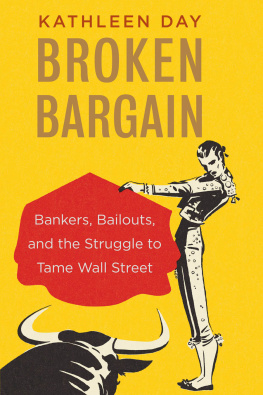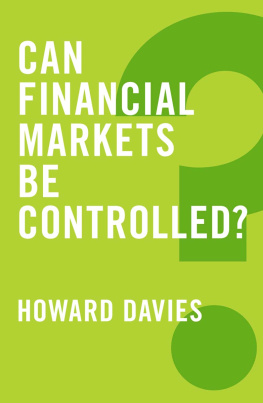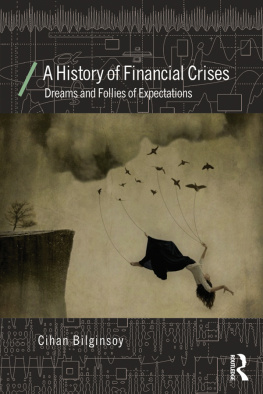BROKEN BARGAIN

Published with assistance from the foundation established in memory of Philip Hamilton McMillan of the Class of 1894, Yale College.
Copyright 2019 by Kathleen Day.
All rights reserved.
This book may not be reproduced, in whole or in part, including illustrations, in any form (beyond that copying permitted by Sections 107 and 108 of the U.S. Copyright Law and except by reviewers for the public press), without written permission from the publishers.
Yale University Press books may be purchased in quantity for educational, business, or promotional use. For information, please e-mail (U.K. office).
adapted in part from Kathleen Day, S & L Hell: The People and the Politics behind the $1 Trillion Savings and Loan Scandal. Copyright 1993 by Kathleen Day. Used by permission of W.W. Norton & Company, Inc.
Set in Times Roman type by IDS Infotech, Ltd.
Printed in the United States of America.
Library of Congress Control Number: 2018943787
ISBN 978-0-300-22332-3 (hardcover : alk. paper)
A catalogue record for this book is available from the British Library.
This paper meets the requirements of ANSI/NISO Z39.48-1992
(Permanence of Paper).
10 9 8 7 6 5 4 3 2 1
This book is for my family,
especially my son, Ian, who wasnt here for the first one,
and my brothers and our parents, who were
It is difficult to get a man to understand something,
when his salary depends upon his not understanding it!
Upton Sinclair, I, Candidate for Governor: And How I Got Licked
CONTENTS
PREFACE
THIS BOOK BEGAN AS A STORY IN THE Washington Post in 2008 in which I compared the thrift crisis of the 1980s to the mortgage crisis of 2007. That story led Georgetown University to ask me to teach an ethics course for a new graduate program in real estate, based on my first book, S&L Hell. The thinking was that one similarity between the thrift crisis and the mortgage crisis was that both involved real estate.
The course became a walk through the recent, major U.S. domestic financial crises and their international ties, from the 1920s through the mortgage meltdown. From the beginning, it was rooted in finance: without an understanding of the basic principles of finance, one cant understand what went wrong in any of these situations. This is not to condemn finance or the people in the industry. To the contrary, it is to recognize the essential role that finance plays in society by studying the damage it inflicts when it goes awry. As Robert J. Shiller, a Nobel Prizewinning economist and frequent critic of Wall Street, puts it: Among the general public, there is clearly a tendency to think of the financial professions as focused on conspiring against them instead of contributing as constructive organs of civil society. Of course, conspiracies here and there are part of history, and part of finance too, but we should not assume the universality of those instances of calculated manipulation and deception, nor forget that the powerful tools... [of finance] help all individuals in our society achieve their varied goals.
Finance is not institutions but people, the decisions they make and the ethics issues their actions raise. In 2013, I was asked to bring an expanded version of the course to Johns Hopkins Carey Business School, where it has evolved into a history of banking and of major U.S. financial crises and, eventually, this book.
U.S. financial history can usefully be broken into two parts: the era before the 1929 crash, which, financially speaking, seems very different and distant to modern eyes, and the era that came after the crash, when much of the financial system we know emerged. While this book focuses on events from the 1920s onward, it also traces the countrys earlier financial history, including back to the American Revolution, albeit much more quickly.
I have covered financial services for several decades, starting at USA Today at its founding nearly forty years ago, then at the Los Angeles Times, and most recently, for more than two decades at the Washington Post. After a time, patterns appeared. Not only were those people in industry and government who were involved in one crisis often involved in the next, but key concepts, from moral hazard to easy credit, played out over and over.
Many, many people in government and the private sector served as sources for this book and for the decades of reporting on which it rests. Many wish to remain anonymous. I thank them for countless instances of help, direction, and enlightenment over the years. They know who they are.
Some people and institutions that have helped me I can thank by name. I do so with the caveat that any mistakes in the book are mine alone.
Alice Martell has been an agent extraordinaire, embracing the idea of this book even as she pushed me to shape it more deeply and clearly. Likewise, William Frucht has been an editor extraordinaire, providing invaluable enthusiasm, thoughtfulness, insight, and editing throughout. In addition, I thank all the other people at Yale University Press who helped bring this book to life, especially Karen Olson, whose wisdom, good humor, and steady hand kept the process on track, and to Julie Carlson, whose good eye and ear and painstaking focus and patience brought the book to the finish.
Colleagues at Johns Hopkins Carey Business School provided support and encouragement, and several deserve special thanks: Librarian Feraz Ashraf helped me track down countless books and navigate the universitys incredible research tools; and librarians Alan Zuckerman and Heather Tapager ferreted out several essential details that had eluded me despite hours of trying.
. I also thank the Will Rogers Memorial Museum for permission to quote the humorist.
Several archives deserve tribute for preserving books and other materials about the countrys financial history and for making them electronically accessible to the public: FRASER, the digital library of U.S. economic, financial, and banking history maintained by the Federal Reserve Bank of Saint Louis; The Gilder Lehrman Institute of American History; Google Books; the HathiTrust community of U.S. and international research libraries; The U.S. National Archives and Records Administration; and the Library of Congress.
Special thanks to Craig G. Wright, archivist at the Herbert Hoover Presidential Library in Iowa, who found several documents that I had not seen before in published accounts of how deposit insurance came to be.
Thank you to David Barr, Christine Blair, Lee Davison, Amy Friend, Robert M. Garsson, Thomas Herzog, Kathleen Keest, Nell Minow, Mary Moore, Raymond Natter, Lew Ranieri, Ellen Schloemer, David Skidmore, Jesse Stiller, and Ed Yingling. Special thanks to Michael Bradfield, former general counsel of the Federal Reserve under Paul Volcker and then of the Federal Deposit Insurance Corp. Bradfield passed away in August 2017, taking with him a vast repository of banking history and wisdom. Our conversations informed my research, and his knowledge and guidance over the years have been invaluable. I am humbled that he took time to help me in the last months of his life.
Many scholars provided essential help. Im grateful to Martha Olney at the University of California at Berkeley, Stephen Ryan and Richard Sylla at New York University Stern School of Business, Arthur E. Wilmarth Jr. at George Washington University, and Elicia P. Cowins at Washington and Lee. I give special thanks for the work of two banking historians, Susan Estabrook Kennedy and Helen M. Burns, whose scholarly, exhaustive books chronicle so well the banking crises of the early 1930s. No one can understand that period without relying on their meticulous research.
Next page





